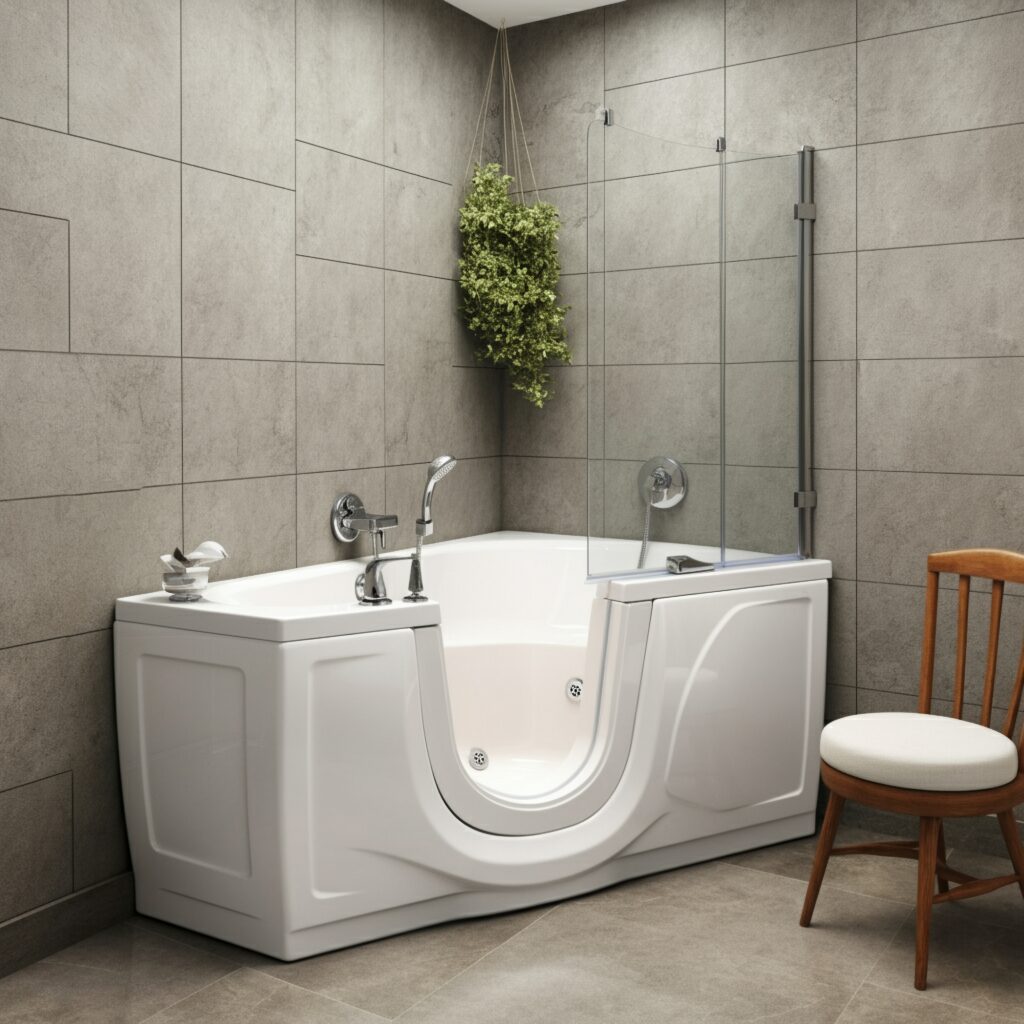Common Walk-In Tub Problems & How to Fix Them

Walk-in tubs are a game-changer for homeowners who want a safe, accessible, and comfortable bathing experience. With their easy-entry doors, built-in seating, and soothing jets, they make bath time more relaxing—especially for seniors or those with mobility concerns.
But like any home feature, walk-in tubs aren’t maintenance-free. Over time, you might run into issues like leaky seals, slow drainage, or malfunctioning jets.
The good news? Many common problems have simple fixes that don’t require a plumber or handyman.
In this guide, we’ll cover the most common walk-in tub problems and how to fix them, plus a few maintenance tips to keep your tub working smoothly.
Table of Contents
Common Walk-In Tub Problems & Solutions
While walk-in tubs are designed for comfort and convenience, they’re not immune to wear and tear. Over time, you might notice leaks, drainage issues, or even electrical malfunctions that can affect your tub’s performance.
Many of these problems have quick and easy fixes that don’t require a costly service call.
Below, we’ll go over some of the most common walk-in tub issues, what causes them, and how you can fix them to keep your tub in top shape.
1. Door Seal Leaks
- Problem: Water leaks around the door, creating puddles on the bathroom floor.
- Causes: Worn-out or improperly sealed gaskets that no longer create a watertight seal.
- Fix: Regularly clean the gasket to remove dirt buildup, check for misalignment, and replace the seal if it’s cracked or deteriorating.
2. Difficulty Opening or Closing the Door
- Problem: The tub door sticks, jams, or doesn’t close properly.
- Causes: Dirt and soap scum buildup, misaligned hinges, or worn-out components.
- Fix: Clean the hinges and door edges regularly, lubricate moving parts, and adjust or tighten hinges if the door is misaligned.
3. Slow Draining or Clogged Drain
- Problem: Water takes too long to drain, leaving you sitting in a puddle.
- Causes: Hair, soap residue, or debris clogging the pipes or a faulty drain mechanism.
- Fix: Clear out blockages with a drain snake or a mild drain cleaner, and make sure the tub’s built-in drainage system is working properly.
4. Malfunctioning Jets or Air Bubbles
- Problem: Weak jets, no bubbles, or inconsistent water pressure.
- Causes: Mineral buildup in the pipes, clogged air lines, or a failing motor.
- Fix: Run a vinegar and water solution through the jets to dissolve buildup, check for loose connections, and service the pump if needed.
5. Water Temperature Issues
- Problem: Water is too hot, too cold, or fluctuates unexpectedly.
- Causes: A faulty thermostat, plumbing issues, or a problem with your home’s water heater.
- Fix: Adjust your water heater settings, inspect the mixing valve, and call a plumber if the issue persists.
6. Electrical Malfunctions
- Problem: The tub won’t turn on, or certain features (jets, heated seats, etc.) stop working.
- Causes: A tripped circuit breaker, faulty wiring, or a malfunctioning control panel.
- Fix: Reset the breaker, check power connections, and replace any faulty electrical components as needed.
7. Mold & Mildew Growth
- Problem: Black spots, musty odors, or visible mildew buildup in or around the tub.
- Causes: Poor ventilation, standing water, or infrequent cleaning.
- Fix: Regularly deep clean the tub with mildew-resistant products, wipe down wet areas after use, and improve bathroom airflow with a fan or dehumidifier.
Taking care of these common walk-in tub issues early on can prevent bigger headaches down the road. With routine maintenance and quick fixes, your tub will continue to provide a safe and relaxing bathing experience
Walk- In Tub Preventative Maintenance Tips
Taking a little time to maintain your walk-in tub is key to preventing common issues like leaks, clogs, and electrical malfunctions. A well-maintained tub not only works better but also lasts longer.
1. Regularly Clean Seals, Drains, and Jets
Over time, dirt, soap scum, and mineral deposits can build up in the door seals, drain, and jets, leading to leaks, slow draining, and weak water pressure. To prevent this:
- Door Seals: Wipe down the rubber gasket after each use to prevent grime buildup. Check for cracks or signs of wear and replace the seal if necessary.
- Drains: Clear out hair, soap residue, and debris regularly to prevent clogging. A simple mix of vinegar and baking soda can help keep drains flowing smoothly.
- Jets: Run a cleaning solution through the jets every few weeks to remove mineral buildup and bacteria. A mix of warm water, vinegar, and a little dish soap works wonders!
2. Check and Replace Worn-Out Components
Walk-in tubs have moving parts like door hinges, latches, and drain plugs that can wear out over time. Regularly inspect these components to ensure everything is functioning properly.
- If your door latch feels loose, tighten it to prevent leaks.
- If the gasket looks cracked or brittle, swap it out before it causes water seepage.
- If the drain mechanism seems sluggish, clean or replace it to avoid standing water in the tub.
3. Ensure Proper Ventilation to Prevent Mold & Mildew
Walk-in tubs create a warm, moist environment—perfect for mold and mildew to thrive. To prevent unwanted buildup:
- Use a bathroom fan or dehumidifier to keep humidity levels in check.
- After each bath, wipe down the tub and leave the door open to let it fully dry.
- Deep clean with a mild disinfectant or mildew-resistant spray once a week to keep your tub fresh and clean.
4. Perform Periodic Inspections of Electrical & Plumbing Connections
Your walk-in tub may have electrical features like heated seats, jets, or LED lights. It also relies on proper plumbing for water flow. To keep everything in working order:
- Check power connections and outlets to ensure the tub is receiving power properly. If you notice flickering lights or a non-functioning control panel, check the circuit breaker.
- Inspect water supply lines for any leaks or unusual water pressure changes. Catching small leaks early can prevent bigger plumbing issues.
- If something seems off—like a tripping breaker or inconsistent water temperature—it might be time to call a professional to take a closer look.
By following these simple preventative maintenance tips, you can keep your walk-in tub working efficiently.
When to Call a Professional
Sometimes, no matter how handy you are, a walk-in tub issue goes beyond a quick DIY fix. While regular maintenance and small repairs can keep your tub running smoothly, there are situations where bringing in a professional is the best (and safest) choice.
Here’s when it’s time to call in the experts:
1. When DIY Fixes Aren’t Enough
Some minor problems can be handled on your own. But if you’ve tried troubleshooting and the issue keeps coming back or gets worse, it’s time to get a professional opinion.
- If water is still leaking even after replacing the door gasket, the tub might not be sealing properly due to a structural issue.
- If you’ve cleared the drain but it’s still slow, there may be a deeper plumbing issue that requires specialized tools to fix.
- If your jets aren’t working after cleaning, the pump or motor might need professional servicing.
When a problem persists despite your best efforts, calling a pro can save you time, money, and frustration.
2. Safety Concerns with Electrical or Plumbing Issues
Walk-in tubs come with electrical and plumbing components, and attempting to repair them yourself can be risky if you’re not experienced.
- If your tub won’t turn on, and resetting the breaker doesn’t fix the issue, there could be faulty wiring or a problem with the control panel. Tampering with electrical components without proper knowledge can be dangerous.
- If your water temperature fluctuates wildly, the issue might be with your home’s plumbing or water heater—both of which can be complex (and messy) to fix on your own.
- If you notice a burning smell, sparks, or water near electrical outlets, turn off the power and call a professional immediately.
When in doubt, it’s always better to be safe than sorry. Electrical and plumbing problems can escalate quickly, so getting a licensed technician involved is the smartest move.
3. The Benefits of Professional Servicing
A professional doesn’t just fix the immediate problem—they can inspect your entire system to catch potential issues before they turn into costly repairs.
- They have the tools and expertise to diagnose hidden leaks, motor issues, and electrical malfunctions.
- A professional can extend the life of your tub by ensuring everything is running efficiently.
- Regular servicing helps prevent unexpected breakdowns, so you’re not stuck with a non-functioning tub when you need it most.
Final Thoughts
A walk-in tub is a great investment in comfort, safety, and accessibility, but like any home feature, it needs a little care to stay in top shape. Addressing small issues before they turn into big problems can save you time, money, and unnecessary headaches.
By keeping up with simple maintenance tasks—like cleaning seals, checking for leaks, and keeping drains clear—you can extend the life of your tub and avoid major repairs. And if something seems beyond a quick fix, don’t hesitate to call in a professional.
Additional Bathroom Remodel Resources
- Choosing the Right Tile for Your Shower
- Do I Need a Permit to Remodel a Bathroom?
- 14 Bathroom Remodel Ideas

Anna has over six years of experience in the home services and journalism industries and serves as the Content Manager at MyHomePros.com, specializing in making complex home improvement topics like HVAC, roofing, and plumbing accessible to all. With a bachelor’s degree in journalism from Auburn University, she excels in crafting localized, comprehensive guides that cater to homeowners’ unique needs. Living on both coasts of the United States has equipped her with a distinctive perspective, fueling her passion for turning any house into a cherished home through informed, personalized decision-making.








